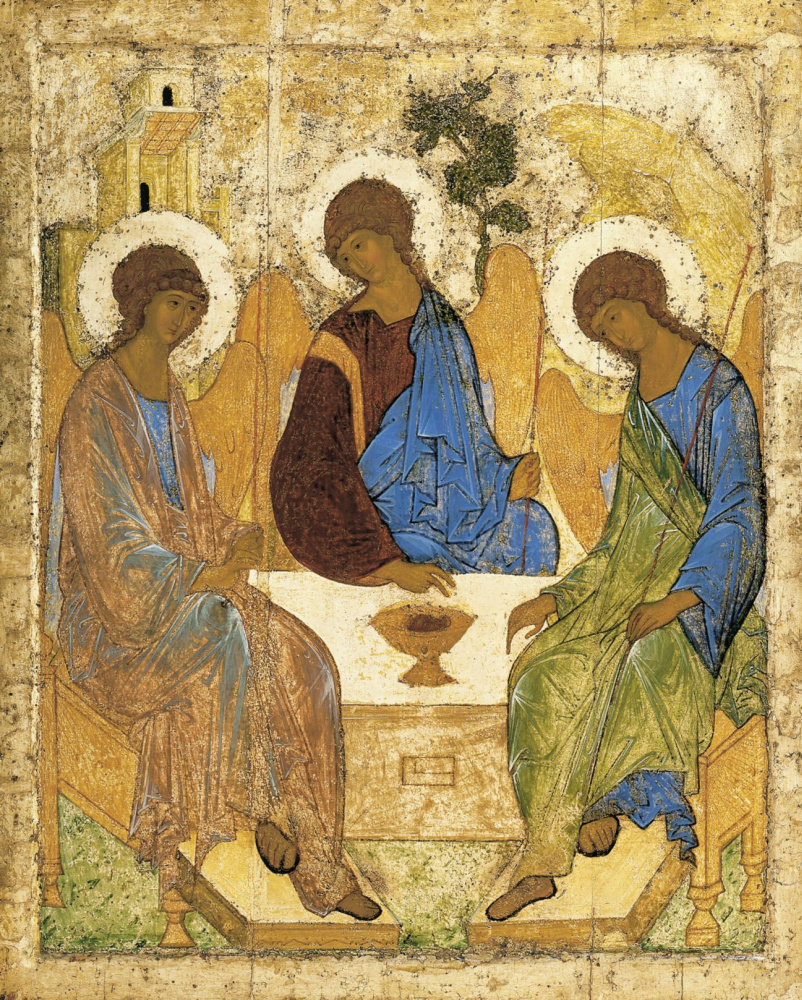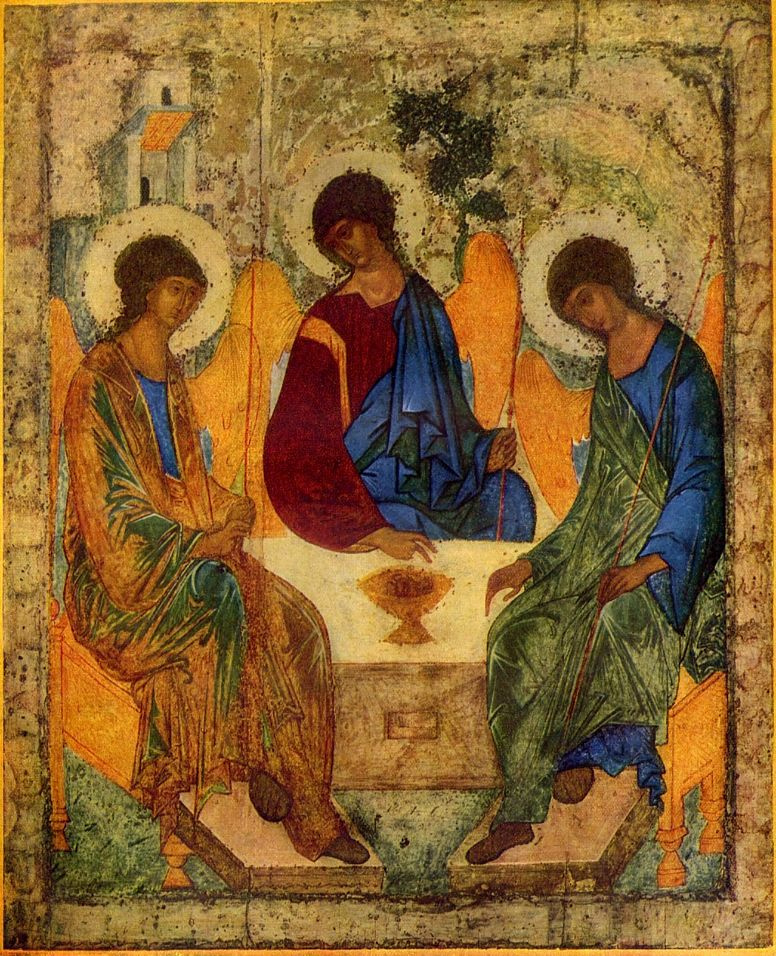log in
Enter site
Login to use Arthive functionality to the maximum
Trinity
Andrey Rublev • Icon painting, 1420-th
, 141×114 cm
Description of the artwork «Trinity»
"Trinity"written by Andrei Rublev, no one has seen for four hundred years. A century after its creation, darkened from candle smoke, covered with linseed oil, it was “ponovili” for the first time, that is, a new layer of paint was put on top. And then another three or four, one another darker and more benevolent. The image was preserved, not painting.
Pavel Florensky saw the real “Trinity” by Andrei Rublev one of the first people in the last few centuries. A unique opportunity for a priest, philosopher and art historian. At the very beginning of the Soviet state, in 1919, he was a member of the Commission for the Preservation of Monuments of Art at the Trinity-Sergius Lavra and was present during the removal of the golden salary, while clearing the later layers, which for centuries lay down on Rublevskaya painting. "There is a" Trinity "Rublev, therefore there is a God"- A few years later Florensky will write in the book "Iconostasis".
This phrase, mystical and theological, at first glance, was written in a very specific philosophical and art history context. There are artists, Florensky argued, who write biblical scenes, going back to their own inspiration in another, spiritual world - and then their images are based on earthly visions, on human faces and actions. They only come off the ground and do not always reach the truth. And there are artists who create paintings, already returning from the world of the highest - and then the images are based solely on the images of this world, seen by spiritual vision. And Andrei Rublev (as well as Raphael, for example) - one of the artists who saw God and saw the truth.
The Trinity has never been a miraculous or healing icon, many lists have not been made from it, such as the Vladimir Icon of the Mother of God. Its amazing effect on man is not explained by miracles, it is a miracle in itself. Pure painting. Soviet art historians and historians who wrote hundreds of monographs for the 600th anniversary of Rublev in the 60s, Andrei Tarkovsky, who showed in his film “The Trinity” only color frames, restorers, believers, priests, visitors to the Tretyakov Gallery, finally - everyone who saw the icon felt unearthly calm and quiet delight.
But along with mystical experiences, Soviet restorers, opening the "Trinity", made it possible also its artistic study. And the delight of art critics was akin to the reverence of believers. Even commenting on the compositional perfection or coloristic solution of the icon, sooner or later they are confused with the terms on emotions: "Charm", "mysterious creative leap", "revelation", "inner harmony". And yet the "Trinity" over the past century have studied enough.
Paints. The Byzantine icons that Rublev saw and studied on were completely different in color. The harmony of color combinations in them was achieved by whitening colors, muted noble, mixed colors. There was no pure color in them, and even more so the contrast of pure colors. Rublev was the first to express purity and unearthly radiance in color. The bright blue used in the "Trinity" is called "Rublevsky stuffed cabbage", still.
Plot. The canonical Old Testament story about Abraham and Sarah, who treated three pilgrims and understood that God himself is at the same table with them, Rublev also performed in a new way. On the hospitable table, one bowl remained, but the owners simply do not exist, as there is no even the action of the treat. It is we who, facing the icon, accept God instead of Abraham and freeze from the wordless intercourse of three angels that have opened to our eyes.
Characters The elements of the landscape that are usual for the iconography of this plot - Mamvriysky oak, the house of Abraham, the mountain - at Rublev become multi-valued symbols, over which critics still argue about. The tree behind the middle angel, most likely Christ, symbolizes resurrection, and its curved trunk, like the zigzag cutout of the chiton, speaks of a difficult, martyric fate awaiting God's son on earth. The mountain is a symbol of the ascent to heaven, “the rapture of the spirit,” which means the right angel is the Holy Spirit. Above the angel, who embodied God the Father, rise the chambers, which is the symbol of "house-building," creation and creation.
Composition. The circular composition of the icon is all the same image of the unity, inseparability, trinity of God, and at the same time a symbol of unity in love. A very important meaning for the period of strife, battle and burning down fires.
But even when thousands of meanings, symbols, characteristics of composition and rhythms are revealed, “Trinity” remains a work carrying an inexplicable “charm”, “mysterious creative leap”, “revelation” and “inner harmony”, the work of a man who saw God.
Author: Anna Sidelnikova
Pavel Florensky saw the real “Trinity” by Andrei Rublev one of the first people in the last few centuries. A unique opportunity for a priest, philosopher and art historian. At the very beginning of the Soviet state, in 1919, he was a member of the Commission for the Preservation of Monuments of Art at the Trinity-Sergius Lavra and was present during the removal of the golden salary, while clearing the later layers, which for centuries lay down on Rublevskaya painting. "There is a" Trinity "Rublev, therefore there is a God"- A few years later Florensky will write in the book "Iconostasis".
This phrase, mystical and theological, at first glance, was written in a very specific philosophical and art history context. There are artists, Florensky argued, who write biblical scenes, going back to their own inspiration in another, spiritual world - and then their images are based on earthly visions, on human faces and actions. They only come off the ground and do not always reach the truth. And there are artists who create paintings, already returning from the world of the highest - and then the images are based solely on the images of this world, seen by spiritual vision. And Andrei Rublev (as well as Raphael, for example) - one of the artists who saw God and saw the truth.
The Trinity has never been a miraculous or healing icon, many lists have not been made from it, such as the Vladimir Icon of the Mother of God. Its amazing effect on man is not explained by miracles, it is a miracle in itself. Pure painting. Soviet art historians and historians who wrote hundreds of monographs for the 600th anniversary of Rublev in the 60s, Andrei Tarkovsky, who showed in his film “The Trinity” only color frames, restorers, believers, priests, visitors to the Tretyakov Gallery, finally - everyone who saw the icon felt unearthly calm and quiet delight.
But along with mystical experiences, Soviet restorers, opening the "Trinity", made it possible also its artistic study. And the delight of art critics was akin to the reverence of believers. Even commenting on the compositional perfection or coloristic solution of the icon, sooner or later they are confused with the terms on emotions: "Charm", "mysterious creative leap", "revelation", "inner harmony". And yet the "Trinity" over the past century have studied enough.
Paints. The Byzantine icons that Rublev saw and studied on were completely different in color. The harmony of color combinations in them was achieved by whitening colors, muted noble, mixed colors. There was no pure color in them, and even more so the contrast of pure colors. Rublev was the first to express purity and unearthly radiance in color. The bright blue used in the "Trinity" is called "Rublevsky stuffed cabbage", still.
Plot. The canonical Old Testament story about Abraham and Sarah, who treated three pilgrims and understood that God himself is at the same table with them, Rublev also performed in a new way. On the hospitable table, one bowl remained, but the owners simply do not exist, as there is no even the action of the treat. It is we who, facing the icon, accept God instead of Abraham and freeze from the wordless intercourse of three angels that have opened to our eyes.
Characters The elements of the landscape that are usual for the iconography of this plot - Mamvriysky oak, the house of Abraham, the mountain - at Rublev become multi-valued symbols, over which critics still argue about. The tree behind the middle angel, most likely Christ, symbolizes resurrection, and its curved trunk, like the zigzag cutout of the chiton, speaks of a difficult, martyric fate awaiting God's son on earth. The mountain is a symbol of the ascent to heaven, “the rapture of the spirit,” which means the right angel is the Holy Spirit. Above the angel, who embodied God the Father, rise the chambers, which is the symbol of "house-building," creation and creation.
Composition. The circular composition of the icon is all the same image of the unity, inseparability, trinity of God, and at the same time a symbol of unity in love. A very important meaning for the period of strife, battle and burning down fires.
But even when thousands of meanings, symbols, characteristics of composition and rhythms are revealed, “Trinity” remains a work carrying an inexplicable “charm”, “mysterious creative leap”, “revelation” and “inner harmony”, the work of a man who saw God.
Author: Anna Sidelnikova




